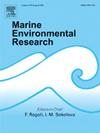Scallop farming impacts on dissolved organic matter cycling in coastal waters: Regulation of the low molecular weight fraction
IF 3
3区 环境科学与生态学
Q2 ENVIRONMENTAL SCIENCES
引用次数: 0
Abstract
To elucidate the impacts of scallop farming on the biogeochemical characteristics of low molecular weight (LMW, <1 kDa) dissolved organic matter (DOM), samples collected from a bay scallop mariculture area (MA) and its surrounding areas were determined for absorption and fluorescence spectroscopy after microfiltration and centrifugal ultrafiltration. The values of absorption coefficient a350 showed a spatial variation trend of inshore area (IA) > MA > non-mariculture area (NMA) for both bulk (<0.7 μm) and LMW fractions. Four fluorescent components, namely two protein-like components (tryptophan-like C1 and tyrosine-like C2) and two humic-like components (microbial humic-like C3 and terrestrial humic-like C4), were identified. Scallop farming influenced DOM transformation by altering phytoplankton abundance and promoting microbial degradation. In July, the net contributions of phytoplankton to the spectroscopy parameters of LMW-DOM in the surface seawater were 11.0% for a350, 4.3% for C1, 0.8% for C2, 0.6% for C3 and 3.0% for C4, respectively; the corresponding values of bulk DOM in the surface seawater were 24.3% for a350, 20.1% for C1, 5.9% for C2, 2.0% for C3, 2.9% for C4, respectively. Compared with NMA, the contributions of microbial degradation to a350 in MA's surface seawater increased by 9.0% for LMW-DOM and 6.9% for bulk DOM in July; however, the effects on different fluorescent components varied. In August, compared with NMA, the contributions of microbial degradation to spectroscopy parameters in the bottom water of MA decreased by 35.7% for a350, 6.3% for C2, 1.3% for C3, and 4.4% for C4 for LMW-DOM fraction; for bulk DOM, the corresponding contribution decreased by 10.8% for C1. These variations indicate that protein-like substances from scallop aquaculture are easily degraded into LMW substances, while humic-like substances degradation diminishes over time.
扇贝养殖对沿海水域溶解有机物循环的影响:低分子量部分的调节
为阐明扇贝养殖对低分子量(LMW,<1 kDa)溶解有机质(DOM)生物地球化学特征的影响,对海湾扇贝养殖区(MA)及其周边地区采集的样品进行了微滤和离心超滤后的吸收和荧光光谱测定。吸收系数 a350 的值显示了近岸区域(IA)> MA > 非养殖区域(NMA)对大体积(<0.7 μm)和低分子量组分的空间变化趋势。确定了四种荧光成分,即两种蛋白质样成分(色氨酸样 C1 和酪氨酸样 C2)和两种腐殖质样成分(微生物腐殖质样 C3 和陆生腐殖质样 C4)。扇贝养殖通过改变浮游植物的丰度和促进微生物降解来影响 DOM 的转化。7月份,浮游植物对表层海水中低分子量DOM光谱参数的净贡献率分别为:a350为11.0%、C1为4.3%、C2为0.8%、C3为0.6%、C4为3.0%;表层海水中大量DOM的相应值分别为:a350为24.3%、C1为20.1%、C2为5.9%、C3为2.0%、C4为2.9%。与北马里亚纳海区相比,7月份马里亚纳海区表层海水中微生物降解对a350的贡献率(LMW-DOM)增加了9.0%,对大量DOM的贡献率增加了6.9%;但对不同荧光成分的影响各不相同。与北马里亚纳海区相比,8 月份马里亚纳海区底层海水中微生物降解对光谱参数的贡献率为:LMW-DOM 部分的 a350 降低了 35.7%,C2 降低了 6.3%,C3 降低了 1.3%,C4 降低了 4.4%;对大体积 DOM 而言,C1 的相应贡献率降低了 10.8%。这些变化表明,扇贝养殖过程中产生的蛋白质类物质很容易降解为低分子量物质,而腐殖质类物质的降解作用则随着时间的推移而减弱。
本文章由计算机程序翻译,如有差异,请以英文原文为准。
求助全文
约1分钟内获得全文
求助全文
来源期刊

Marine environmental research
环境科学-毒理学
CiteScore
5.90
自引率
3.00%
发文量
217
审稿时长
46 days
期刊介绍:
Marine Environmental Research publishes original research papers on chemical, physical, and biological interactions in the oceans and coastal waters. The journal serves as a forum for new information on biology, chemistry, and toxicology and syntheses that advance understanding of marine environmental processes.
Submission of multidisciplinary studies is encouraged. Studies that utilize experimental approaches to clarify the roles of anthropogenic and natural causes of changes in marine ecosystems are especially welcome, as are those studies that represent new developments of a theoretical or conceptual aspect of marine science. All papers published in this journal are reviewed by qualified peers prior to acceptance and publication. Examples of topics considered to be appropriate for the journal include, but are not limited to, the following:
– The extent, persistence, and consequences of change and the recovery from such change in natural marine systems
– The biochemical, physiological, and ecological consequences of contaminants to marine organisms and ecosystems
– The biogeochemistry of naturally occurring and anthropogenic substances
– Models that describe and predict the above processes
– Monitoring studies, to the extent that their results provide new information on functional processes
– Methodological papers describing improved quantitative techniques for the marine sciences.
 求助内容:
求助内容: 应助结果提醒方式:
应助结果提醒方式:


